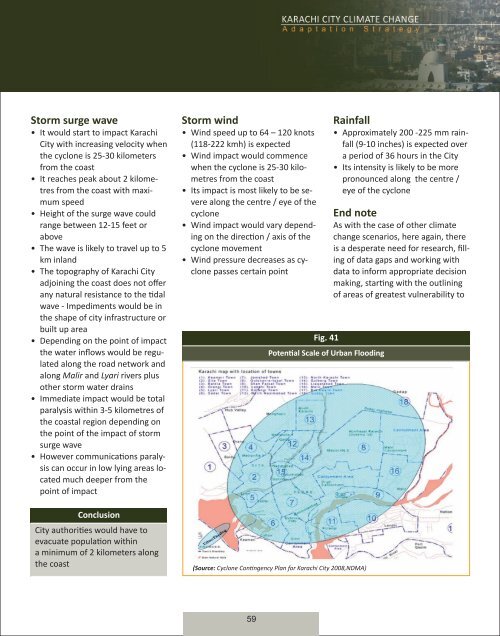27915_100286295karachicityclimatechangead
27915_100286295karachicityclimatechangead
27915_100286295karachicityclimatechangead
Create successful ePaper yourself
Turn your PDF publications into a flip-book with our unique Google optimized e-Paper software.
Storm surge wave• It would start to impact KarachiCity with increasing velocity whenthe cyclone is 25-30 kilometersfrom the coast• It reaches peak about 2 kilometresfrom the coast with maximumspeed• Height of the surge wave couldrange between 12-15 feet orabove• The wave is likely to travel up to 5km inland• The topography of Karachi Cityadjoining the coast does not offerany natural resistance to the tidalwave - Impediments would be inthe shape of city infrastructure orbuilt up area• Depending on the point of impactthe water inflows would be regulatedalong the road network andalong Malir and Lyari rivers plusother storm water drains• Immediate impact would be totalparalysis within 3-5 kilometres ofthe coastal region depending onthe point of the impact of stormsurge wave• However communications paralysiscan occur in low lying areas locatedmuch deeper from thepoint of impactConclusionCity authorities would have toevacuate population withina minimum of 2 kilometers alongthe coastStorm wind• Wind speed up to 64 – 120 knots(118-222 kmh) is expected• Wind impact would commencewhen the cyclone is 25-30 kilometresfrom the coast• Its impact is most likely to be severealong the centre / eye of thecyclone• Wind impact would vary dependingon the direction / axis of thecyclone movement• Wind pressure decreases as cyclonepasses certain pointFig. 41potential Scale of urban Flooding(Source: Cyclone Contingency Plan for Karachi City 2008,NDMA)rainfall• Approximately 200 -225 mm rainfall(9-10 inches) is expected overa period of 36 hours in the City• Its intensity is likely to be morepronounced along the centre /eye of the cycloneEnd noteAs with the case of other climatechange scenarios, here again, thereis a desperate need for research, fillingof data gaps and working withdata to inform appropriate decisionmaking, starting with the outliningof areas of greatest vulnerability to59












